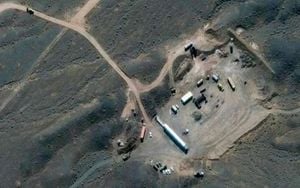Unidentified drones flying over Danish military bases and critical infrastructure have triggered a wave of alarm across Denmark and neighboring countries, intensifying concerns about aerial security in northern Europe. The latest incidents, which occurred overnight from Friday, September 26 to Saturday, September 27, 2025, saw drones observed at multiple Danish Defence facilities, including the country's largest base, Karup Air Base, as well as Skrydstrup Air Base and the Jutland Dragoon Regiment.
According to the Danish Defence Ministry, “drones have been observed at several of Danish Defence’s locations last night. Several capabilities were deployed,” though officials declined to elaborate further due to operational security and the ongoing investigation. The Ministry’s statement, echoed by local and international media, did not specify all the affected sites, but local reports and police sources confirmed drone activity at Karup around 8 p.m. local time. Simon Skelkjær, duty manager at the Central and West Jutland Police, told Danish public broadcaster DR that drones were seen both inside and outside the fence at Karup, and that airspace was closed to civil air traffic for a period of time. However, as there were no scheduled commercial flights at that hour, the closure had no practical impact.
The Karup base is no ordinary installation—it houses all of the Danish Armed Forces' helicopters, airspace surveillance, flight school, and support functions. It shares its runways with the Midtjylland civilian airport, further underscoring the potential risk posed by such aerial incursions. Some 3,500 people work at the facility, making it a linchpin of Denmark’s military infrastructure.
This recent spate of drone sightings is not an isolated event. Over the past week, Denmark has experienced a series of mysterious drone incursions near airports and other critical infrastructure. On Monday, September 22, drones were spotted above Copenhagen Airport, Scandinavia’s busiest, forcing it to close for several hours. Two to three large, unidentified drones were observed, grounding outgoing flights and diverting others. Jens Jespersen of the Copenhagen Police remarked, “the number, large size and flight patterns of the unidentified drones combined indicated that it is a capable actor. Which capable actor, I do not know.”
Following the Copenhagen incident, similar drone activity led to the temporary closure of five smaller airports, including Aalborg and Billund, as well as military facilities. In each case, authorities scrambled to respond, but the perpetrators remained elusive. The repeated unexplained activity has heightened alert levels not only in Denmark but also across the region. Oslo airport in Norway was closed for several hours after drone sightings, and police in Norway seized a drone near Oslo’s airport, though no direct link to the Danish incidents has been established. Meanwhile, Germany reported several drones over Schleswig-Holstein, the northern state bordering Denmark, and Lithuania experienced drone-related flight delays at Vilnius airport.
The timing of these incursions has not gone unnoticed. They began just days after Denmark announced plans to acquire long-range precision weapons for the first time, citing Russia as a persistent threat to European security. Danish Prime Minister Mette Frederiksen described the events as “hybrid attacks,” a term referring to a mix of military and non-military tactics designed to disrupt a nation’s infrastructure or institutions. She stated, “over recent days, Denmark has been the victim of hybrid attacks,” and pointed to Russia as “the main country that poses a threat to Europe’s security.”
Defence Minister Troels Lund Poulsen added that the flights appeared to be “the work of a professional actor.” While Danish authorities have not publicly accused any specific party, suspicions of Russian involvement have been widely reported. However, Moscow has firmly rejected such allegations, calling them “a staged provocation.” The Russian embassy in Copenhagen labeled the claims “absurd speculations,” while Kremlin spokesman Dmitry Peskov dismissed them as “unfounded.”
Context for these suspicions is provided by a broader pattern of drone and fighter jet incursions involving NATO member states. Earlier in September, around 20 Russian drones crossed into Polish airspace, and Russian MiG-31 jets violated Estonian airspace. Romania also reported a Russian drone breaching its territory. These incidents prompted Estonia and Poland to request consultations with other NATO members, reflecting the growing anxiety over indirect aggression in the region. According to BBC, “Europe has been on high alert after several NATO member states reported Russian incursions in their airspaces.”
German authorities are taking the threat seriously. Sabine Sütterlin-Waack, interior minister of Schleswig-Holstein, said, “state police are currently significantly stepping up their drone defense measures, also in coordination with other northern German states.” German Chancellor Friedrich Merz, speaking at the Schwarz Ecosystem Summit in Berlin, warned, “we are not at war, but we are no longer living in peace either.” He referenced a litany of security challenges, including drone flights, espionage, cyberattacks, and sabotage, saying, “acts of sabotage on a daily basis. Attempts to paralyze data centers. Cyberattacks.”
Back in Denmark, the government is not standing still. Justice Minister Peter Hummelgaard described the drone flyovers as attempts to “sow fear and division,” and announced plans to propose legislation that would allow infrastructure owners to shoot down unauthorized drones. The Danish Defence Ministry also confirmed that, for the upcoming European Union summit scheduled for October 1 and 2 in Copenhagen, Denmark had accepted an offer from Sweden to “lend Denmark a military anti-drone capability.” Details of the arrangement remain confidential, but the move underscores the seriousness with which officials view the threat.
The European Union is responding at a broader level as well. On September 26, defence ministers from about 10 EU countries agreed to prioritize the creation of a “drone wall” for the bloc, learning from Ukraine’s experience with drone warfare. EU Defence Commissioner Andrius Kubilius told AFP, “We need to move fast. And we need to move, taking all the lessons from Ukraine and making this drone wall together with Ukraine.”
While investigations continue and officials work to shore up defenses, the identity and motives of those behind the drone incursions remain unclear. No one has claimed responsibility, and authorities have yet to present concrete evidence linking the incidents to any nation or group. The only certainty is that the recent wave of drone activity has exposed vulnerabilities in Europe’s aerial security and forced a reckoning with the realities of modern hybrid threats.
As Denmark prepares to host the EU summit under heightened security and with new anti-drone measures in place, the country—and its neighbors—are bracing for whatever comes next. For now, the skies over Scandinavia remain a contested and closely watched frontier.






